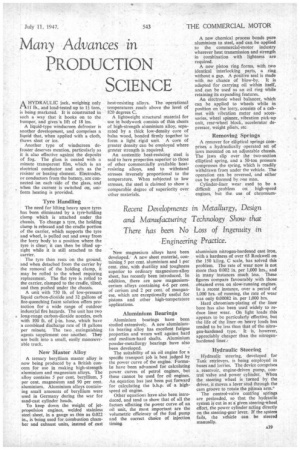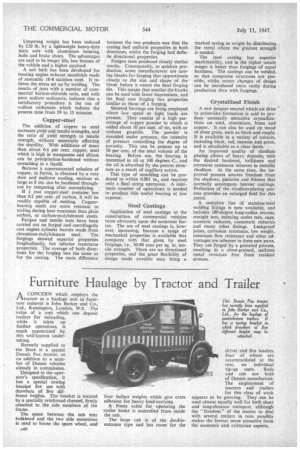Many Advances in
Page 49

Page 50

If you've noticed an error in this article please click here to report it so we can fix it.
PRODUCTION SCIENCE
A HYDRAULIC jack, weighing only CAI 1 lb., and load-tested up to I/ tons, is being marketed. It is constructed in such a way that it hooks on to the bumper, and gives 'a lift of 18 ins.
A liquid-type windscreen defroster is another development, and comprises a liquid that, when applied with a cloth, thaws sleet or ice.
Another type of windscreen defroster deserves mention, particularly as it is also effective against the deposits of fog. The glass is coated with a minute transparent film, which is an electrical conductor and acts as the resister or heating element. Electrodes, or conductors from the battery, are connected an each , side of the glass, and when the current is switched on, uniform heating is provided.
Tyre Handling
The need for lifting heavy spare tyres has been eliminated by a tyre-holding clamp which is attached under the chassis. To change a tyre, the holding clamp is released and the cradle portion of the carrier, which supports the tyre and wheel, is pulled out and away from the lorry body to a position where the tyre is clear; it can then be tilted upright while it is still attached to the carrier.
The tyre then rests on the ground, and when detached from the carrier by the removal of the holding clamp, it may be rolled to the wheel requiring replacement. The flat tyre is rolled to the carrier, clamped to the cradle, tilted, and then pushed under the chassis.
A unit with 750 lb. of low-pressure liquid carbon-dioxide and 32 gallons of fire-quenching foam solution offers protection for a wide range of outdoor industrial fire hazards. The unit has two . long-range carbon-dioxide nozzles, each with 100 ft. of hose, which have a combined discharge rate of 18 gallons per minute. The two extinguishing agents supplement one another. They are built into a small, easily manceuvrable truck.
New Master Alloy A ternary beryllium master alloy is now being produced by a British concern for use in making high-strength aluminium and magnesium alloys. The alloy contains 5 per cent. beryllium, 5 per cent, magnesium and 90 per cent. aluminium. Aluminium alloys containing small amounts of beryllium were used in Germany during the war for sand-cast cylinder heads.
To keep down the weight of jetpropulsion engines, welded stainless steel sheet, in a gauge as thin as 0.022 in., is being used for combustion chamber and exhaust units, instead of cast heat-resisting alloys. The operational temperatures reach above the level of 820 degrees C.
A lightweight structural material for use in bodywork consists of thin sheets of high-strength aluminium alloy, separated by a thick low-density core of balsa wood, bonded firmly together to form a light rigid unit. A core of greater density can be employed where greater strength is required.
An austenitic heat-resisting steel is said to have properties superior to those of other commercially available heatresisting alloys, and to withstand stresses inversely proportional to the temperature. When subjected to low stresses, the steel is claimed to show a comparable degree of superiority over other materials.
New magnesium alloys have been developed. A new sheet material, containing 5 per cent. aluminium and 1-per cent. zinc, with ductility and toughness superior to ordinary magnesium-alloy sheet, has recently been introduced. In addition, there are now magnesiumcerium alloys containing 4-6 per cent. of cerium and 2 per cent. of manganese, which are exceptionally useful for pistons and other high-temperature applications.
Aluminium Bearings
Aluminium bearings have been studied extensively. A new aluminiumtin bearing alloy has excellent fatigue properties and wears well against hard and medium-hard shafts. Aluminium powder-metallurgy bearings have also been developed. The suitability of an oil engine for a specific transport job is best judged by the power curve of the engine. FormuIn have been advanced for calculating power curves of petrol engines, but these cannot be used for oil engines. An equation has just been put forward for calculating the b.h.p. of a highspeed oil engine. Other equations have also been introduced, and tend to show that of all the factors affeeting the power curve of an oil unit, the most important are the volumetric efficiency of the fuel pump and the correct choice of injection
A new chemical process bonds pure aluminium to steel, and can be applied to the commercial-motor industry wherever heat transmission and strength in combination with lightness are required.
A new piston ring forms, with two identical interlocking parts, a ring without a gap. A positive seal is made with no chance of blow-by. It is adapted for carrying oil within itself, and can be used as an oil ring while retaining its expanding features.
An electronic wheel balancer, which can be applied to wheels while in position on the lorry, consists of a cabinet with vibration meter and accessories, wheel spinner, vibration pick-up unit, rear-wheel block, accelerator depressor, weight pliers, etc
• Removing Springs
A remover for elliptical springs comprises a hydraulically operated set of jaws mounted on an adjustable chassis. The jaws slip over the two-section elliptical spring, and a 50-ton pressure compresses the spring, which is readily withdrawn from under the vehicle. The operation can be reversed, and either can be performed by one man.
Cylinder-liner wear used to be a difficult problem on high-speed engines, but the use of chromium aluminium nitrogen-hardened oast iron, with a hardness of over 65 Rockwell on the 150 kilog. C scale, has solved this problem. The rate of wear now is not more than 0.002 in. per 1,000 hrs, and in many instances much less. These figures compare favourably with those obtained even on slow-running engines. In a recent instance, over a period of 1,000 hrs. of running, the rate of wear was only 0.00082 in. per 1,000 hrs.
Hard chromium-plating of the liner bore has also been used widely to reduce liner wear. On light loads this appears to be particularly effective, but the life of the liner on heavy loads has tended to be less than that of the nitrogen-hardened type. It is, however, appreciably cheaper than the nitrogenhardened liner.r.
Hydraulic Steering
Hydraulic steering, developed for Tank retrievers, is being employed in buses and lorries. The device comprises a reservoir, engine-driven pump, control valve and power cylinder. When the steering wheel is turned by the driver, it moves a lever stud, through the cam groove to rotate the pitman arm.' The control-valve centring springs are preloaded, so that the hydraulic system is cut in at a given steering-wheel effort, the power cylinder acting directly on the steering-gear lever. If the system fails, the vehiele can be steered manually. Unsprung weight has been reduced by 220 lb. by a lightweight heavy-duty lorry axle with aluminium housing, hubs and brake shoes. The advantages are said to be longer life, less bounce of the vehicle and a higher payload.
A salt bath has been developed for treating engine exhaust manifolds made of austenitic 18-8 stainless steel. It relieves the stress set up by welding. The results of tests with a number of commercial barium-chloride salts, and with pure sodium carbonate, indicate that a satisfactory procedure is the use of sodium carbonate which reduces the process time from 59 to 15 minutes.
Copper-steel
The addition of copper to steel increases yield and tensile strengths, and the ratio of yield strength to tensile strength, without materially affecting the ductility. With additions of more than about 0.6 per cent, copper, steel which is high in manganese and silicon can be precipitation-hardened without quenching in a liquid.
Because a supersaturated solution of copper, in ferrite, is obtained by a very slow and uniform cooling, sections as large as 8 ins, can be hardened throughout by tempering after normalizing.
If a cast copper-steel contains less than 0.2 per cent, of carbon, it will be readily capable of welding. Copperbearing steels are more resistant to scaling during heat treatment than plain carbon, or carbon-molybdenum steels.
Fatigue and tensile tests have been carried out on forged and centrifugally cast engine cylinder barrels made from chromium-molybdenum steel. The forgings showed superior properties longitudinally, but inferior transverse properties. The average of both directions for the forging was the same as for the casting. The main difference between the two products was that• the casting had uniform properties in both directions, whilst the forging had definite directional properties.
Fatigue tests produced closely similar results. Consequently, to quicken production, some manufacturers are casting blanks for forging that approximate closely to the size and shape of the blank before it enters the final forging die. This means that smaller die-blocks can be used with fewer impressions, and the final cast forging has properties similar to those of a forging.
Sintered bearings are being employed where low speed or light loads are present. They consist of a high percentage of copper powder to which is added about 10 per cent. of tin, with or without graphite. The powder is moulded under pressure, the intensity of pressure controlling the degree of porosity. This can be present up to 30 per cent, of the total volume of the bearing. Before use, the bearing is immersed in oil at 100 degrees C., and the oil is absorbed by the porous structure as a result of capillary action.
This type of moulding can be produced to within 0,001 in., and requires only a final sizing operation. A minimum number of operations is needed to produce this useful bearing at low expense.
Steel Castings
Application of steel castings to the construction of commercial vehicles turns obviously upon the economic factor. The use of steel castings is, however, increasing, because a range of mechanical properties is available that compares with that given by steel forgings, i.e., 30-80 tons per sq. in. tensile strength. There are no directional properties, and the great flexibility of design made possible may bring a marked saving in weight by distributing the metal where the greatest strength is needed.
The steel casting has superior machinability, and in the higher tensile ranges is better than forgings of equal hardness. The castings can be welded, so that composite structures are possible, whilst, minor changes of design can be introduced more easily during production than with forgings.
Crystallized Finish
A new lacquer enamel which air dries to prism-like formation is said to produce unusually attractive crystallizations on steel, aluminium, brass and copper. It can also be used on wood of close grain, such as bitch and maple. It is available in a variety of colours, including black, red, maroon and green, and is obtainable as a clear finish.
An improved quality of rhodium plating allows of heavy deposits, with the desired hardness, brilliance and corrosion resistance inherent in metallic rhodium. At the same time, the improved process assures freedom from the shadows, pinholes and blisters that normally accompany heavier coatings. Perfection of the rhodium-plating process provides an enlarged field for this metal.
A complete line of stainless-steel welding fittings is now available, and includes 180-degree long-radius returns, straight tees, reducing outlet tees, caps, eccentric reducers, concentric reducers and many other fittings. Leakproof joints, corrosion resistance, low weight, minimum flow resistance and other advantages are inherent in these new parts. They are forged by a patented process, resulting in a close-grained, uniform metal structure free from residual stresses.












































































